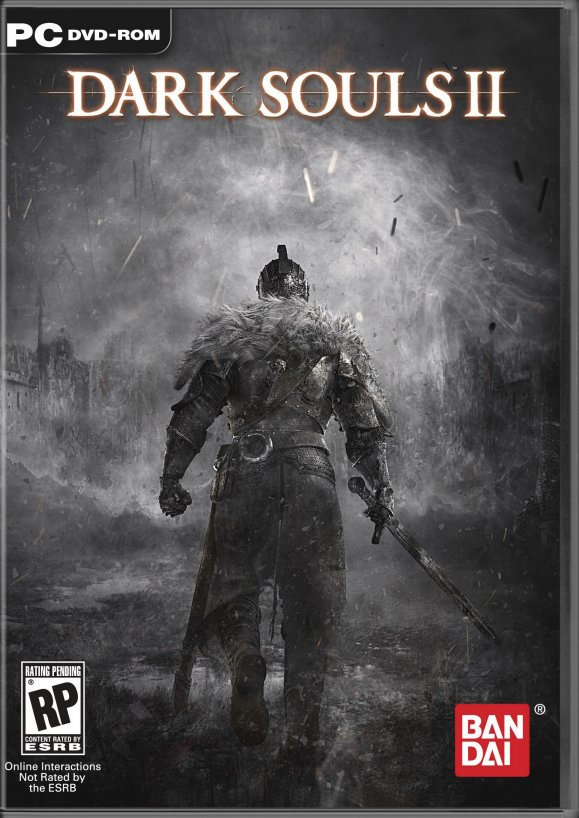Dark Souls II Review
-
Category: ReviewsHits: 12872

Article Index
Combat and Mechanical Nitpicks
At the cost of angering the orthodox defenders of Demon's Souls and Dark Souls, I have to admit that Dark Souls II has my favorite iteration of the series' trademark combat. It's slower, more methodical, slightly more stat-based and both the human characters and monsters tend to have more obvious wind-up to their moves, which admittedly makes them easier to dodge, but also reduces the emphasis on reaction and moves it to planning and executing. That said, there are a few fatal flaws that make it difficult to call it an overall improvement. First of all, hitboxes tend to be less polished and, for lack of a better word, "looser" this time around. It always takes a while to get used to the larger bosses' dodge timings because all too often they have a wider and longer reach than they seemingly should, and unfortunately this is also problem for plenty of minor enemies, though not to that degree. Secondly, a few techniques that were fairly easy to pull off in previous games have been made both less useful and much more difficult to execute, with the parrying windows in particular being really strict for no apparent reason, especially considering a lot of enemies have surprisingly fast recovery times.
Aside from combat feeling different from the predecessors, Dark Souls II also brings quite a few mechanical tweaks that change the overall feel of the game. Healing is still handled primarily with Estus Flasks, sort of healing potions that recharge when resting at a bonfire or after death, but the game is designed so you better learn their value. While Dark Souls would offer you 5 charges right off the bat, in Dark Souls II you start with only one, and have to find Estus Shards to get extra charges, for a maximum of 12 in total. Luckily the game supplies you with consumables to make up for it: Lifegems slowly recharge your health but can be used while moving, while other more limited items like Monastery Charms also have secondary effects and heal more quickly. Truth be told, this kind of interplay matters much more during a first playthrough, as by the end of the game a player has usually enough Estus charges to rely solely on the Flasks. After all, especially in New Game+ and beyond, enemy attacks get more and more lethal, and the challenge switches from handling your resources effectively to finding the right timing to heal in between attacks.
Speaking of New Game+, Dark Souls II features the best implementation of this mechanic in the entire series, with remixed enemy encounters (even a few bosses get some new tricks up their sleeves), new loot drops and even some important lore hints. Should you not want to delve into New Game+, it's also possible to keep playing after defeating the final boss, and even challenge some bosses again in their stronger forms with the use of a new item, the Bonfire Ascetic, which respawns enemies and strengthens them. Ascetics are also needed to effectively farm in the game, because most enemies stop respawning after being killed enough times, and a few unique sets are only dropped in pieces from unique NPC red phantoms, a befuddling and annoying design decision. The durability of unique drops and every other item in the game is also handled differently: equipment is now automatically repaired to full durability at bonfires and only needs to be repaired by a blacksmith in case it breaks down completely, turning what was originally mostly a soul tax into an interesting gameplay element, given many powerful weapons have low durability or lose quite a lot of it if you use their special attacks.
I can't realistically list all of the gameplay changes, but I'll cite just a few more: it's now possible to wear four rings at one time, but they all have weight and contribute to your overall equipment load, potentially making the difference between a fast and a slow roll; it's possible to equip three items in each hand rather than two, and 10 items in total on your quick-slot item belt, although I wouldn't recommend doing the latter given circling between items is still clunky; torches can be used to solve a few environmental puzzles and illuminate the rare dark areas, though they're best used sparingly considering they occupy your character's left hand; spell casts can be regenerated by the use of special herb items, similarly to how you'd regenerate Mana in Demon's Souls. Overall, the game feels legitimately different from the original, but it's a much subtler shift than the one that occurred between Demon's Souls and Dark Souls.
Lore, Art and Music
Dark Souls II's plot mirrors its gameplay by being deceptively straightforward and hiding a great amount of thought and interesting ideas, but ultimately doesn't provide the same certainty of outcomes that the game so loudly celebrates with its infamous on-screen messages (always keen to state the obvious, whether that is your death or your victory). The starting cutscene and the ample amounts of in-game dialogue in Majula might lead a player to believe that answers are only a few bosses away, but in truth even the ending is enigmatic, and the background of the world remains shrouded in mystery, moreso even than in the original title, a title to which Dark Souls II pays clear homage and with which establishes clearer ties than I would have expected. Fans are already having fun trying to pierce together the snippets of lore delivered via item descriptions, dialogue and environmental art into a coherent whole, probably fully aware of the fact that it's ultimately a futile exercise, in part because of the ownership that can be claimed over the game's story that way. Looking besides the "plot", one would also find tragic characters (this time more understated and less eccentric than in previous titles) and extremely interesting thematic strands and motifs. For what it's worth, I've grown especially interested in the way sinking and re-emerging seem prevalent artistic theme, deeply embedded into the level design, and the way the game's cycle motif ties both into the game's story and its nature of sequel to a cult title.


